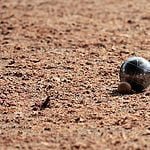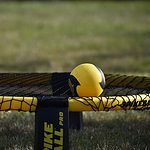In the gentle world of indoor pickleball, not all spheres are created equal. As you navigate the smooth surfaces of indoor courts, you'll find that your choice of ball can make or break your game.
The balls you're accustomed to using outdoors may not perform with the same finesse when brought into the less forgiving environment of a gymnasium or recreational center. You'll want to seek out balls specifically designed for indoor play, characterized by their soft construction and larger holes, which work together to provide a different flight pattern and bounce.
While the Onix Fuse and Franklin X-26 are often favored among enthusiasts, it's crucial to consider the unique dynamics of your local facility. So, before you commit to your next serve, let's examine what sets these indoor pickleballs apart and why it matters to your strategy and performance on the court.
Keep in mind that the right choice can elevate your game, and there's much to explore regarding the subtle yet significant differences between the various options at your disposal.
Key Takeaways
- Indoor pickleballs are designed with 26 wider holes and have an average hole diameter of .43 inches.
- Indoor pickleballs are softer and lighter than outdoor pickleballs, with an average weight of .917 ounces.
- When selecting an indoor pickleball, factors to consider include bounce, noise level, and ball control. Popular options include Onix Fuse, Franklin X-26, Penn 26, and GAMMA Photon.
- Indoor pickleballs are more durable than outdoor pickleballs and are suitable for players at all skill levels.
Characteristics of Indoor Pickleballs
Understanding the characteristics of indoor pickleballs is crucial, as they're specifically designed with 26 wider holes and a softer construction to enhance play on smooth indoor courts. Unlike their outdoor counterparts, which have 40 tightly-packed holes, indoor balls are engineered with fewer holes, averaging about .43 inches in diameter. This design choice is intentional, optimizing the ball for indoor conditions.
You'll notice that indoor pickleballs are lighter, weighing approximately .917 ounces, in contrast to the slightly heavier outdoor balls at .925 ounces. This weight difference affects how the ball moves through the air, with indoor balls offering a lighter touch and feel. Moreover, the softness of indoor balls impacts their speed and bounce. They're generally softer than outdoor pickleballs, resulting in a slower game that emphasizes control and precision when playing indoors.
The lower bounce of indoor pickleballs caters to the smooth surfaces found in indoor facilities. This characteristic demands a more strategic game, where shot placement and finesse are key. As you play, you'll appreciate how these balls are tailored to the unique environment of indoor pickleball, providing a distinct experience from outdoor play.
Comparing Indoor and Outdoor Balls
When you compare indoor and outdoor pickleballs, you'll find that the distinct differences in design, such as the number of holes and material hardness, greatly influence how each ball performs in its respective environment.
The indoor ball typically features 26 holes, allowing it to travel more smoothly through the air with less wind resistance, which is ideal for indoor play where conditions are more controlled. In contrast, the outdoor ball has about 40 holes, designed to withstand the unpredictability of outdoor elements like wind.
Differences between indoor and outdoor balls are also evident in their weight and hardness. Outdoor balls are generally heavier, helping them resist the wind and offer a more aggressive bounce on harder surfaces. The lighter indoor balls provide a slower game that emphasizes control and precision.
Moreover, the hardness of an outdoor ball, made from harder plastic, affects its speed and bounce, but this also means they tend to crack more quickly. Indoor pickleballs, while softer, are more durable and better suited for the indoor court's gentler play conditions.
In short, whether you choose an indoor or outdoor ball, understanding these differences will help you optimize your game for the environment you're playing in.
Selecting the Ideal Indoor Pickleball
Selecting the ideal indoor pickleball hinges on your preference for playability, including factors like bounce, noise level, and ball control within indoor environments. Indoor pickleballs, designed specifically for gymnasiums and sports complexes, offer a different experience than their outdoor counterparts. With 26 wider holes and a softer composition, these balls provide lower bounce and less noise, which is particularly beneficial in echo-prone indoor settings.
When selecting the ideal indoor pickleball, consider the Onix Fuse Indoor Pickleball. It's a popular choice that satisfies the need for a controlled game, allowing for precise shots and strategy. The Franklin X-24, Penn 26, and GAMMA Photon are also approved options that offer varying pack sizes and price points, catering to both casual players and competitive enthusiasts.
If you're looking for something different, foam pickleballs like the GAMMA Quick Kids Foam Ball or Quick Start 36 Foam Ball could be a fun alternative. They're an excellent choice for those who require a gentler option or are introducing the sport to newcomers.
Top Picks for Indoor Pickleballs
Having covered what to consider when choosing an indoor pickleball, let's now examine the top picks that stand out in design and performance.
When it comes to indoor vs outdoor pickleballs, indoor balls typically have larger holes and are lighter due to different playing conditions.
First, consider the Onix Fuse Indoor Pickleballs, which are known for their consistency and soft feel. They're well-regarded in the pickleball community for their balance and are a common choice for players at all skill levels.
Next, the Franklin X-26 Indoor Pickleballs offer superb durability and a fine-tuned design that responds well to the indoor court environment. Their smooth seam and reliable bounce make them a popular choice for competitive play.
Lastly, the GAMMA Photon Indoor Pickleballs are favored for their high-visibility and balanced flight characteristics. They're designed to perform well on gym floors and other indoor surfaces.
- Onix Fuse: Preferred for balance and softness.
- Franklin X-26: Durable with a reliable bounce.
- GAMMA Photon: High visibility and balanced flight.
Pack sizes and prices vary, so you can find 3-packs for casual play or bulk boxes for clubs and frequent players.
Maintenance Tips for Indoor Balls
To ensure your indoor pickleballs remain in top condition, regularly clean them with a damp cloth to eliminate dirt and sweat accumulation. This simple act can significantly impact how well your pickleballs perform during play.
Remember, the various pickleballs on the market have different compositions, and knowing how your indoor pickleballs are made helps in maintaining them properly.
Store your indoor pickleballs in a cool, dry place. Extreme temperatures and moisture can warp or damage the balls, leading to inconsistent bounce and flight patterns. It's also wise to keep them away from direct sunlight, which can degrade the materials over time, and harsh chemicals that might corrode the surface.
Before you hit the court, inspect each ball for cracks, dents, or other deformities. Playing with damaged balls not only affects the game but could also pose a safety risk. Additionally, rotate the balls you use during practice to evenly distribute wear and tear. This rotation is one of the essential maintenance tips for indoor balls, ensuring that all your equipment lasts longer and performs reliably.
Common Questions About Indoor Pickleballs
After learning how to maintain your indoor pickleballs, you might wonder what distinguishes them from their outdoor counterparts and how to select the right one for your game.
Indoor pickleballs typically have 26 holes and are made from a softer plastic, resulting in lower bounce and quieter play. These features make them ideal for controlled, precise play in noise-sensitive environments.
When choosing a ball used for indoor pickleball, consider the following:
- Hole Count and Size: Indoor balls have fewer and wider holes than outdoor balls, affecting the ball's flight and bounce.
- Material and Weight: Indoor pickleballs are lighter and made of softer plastic, enhancing playability on indoor surfaces.
- Noise Level: Due to their design, indoor balls produce less noise, which is crucial in shared or echo-prone spaces.
Common questions about indoor pickleballs often revolve around their performance and suitability for different play settings. Remember that while the average weight difference between indoor and outdoor balls is less than 1%, the playing experience can vary significantly. Approved balls like Onix Fuse and Franklin X-24 provide consistency and reliability, whereas non-approved options such as Jugs offer unique play opportunities and are great for recreational use.





